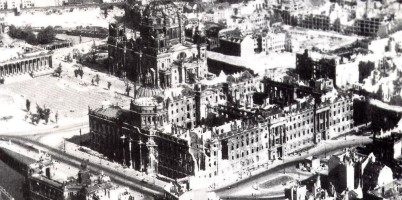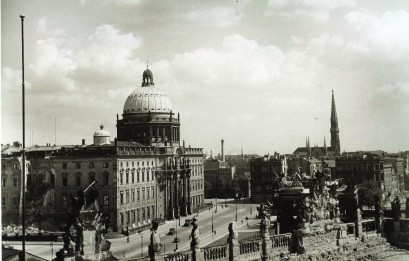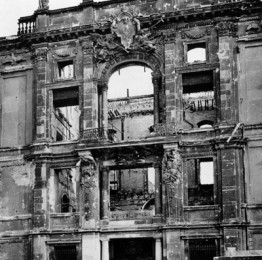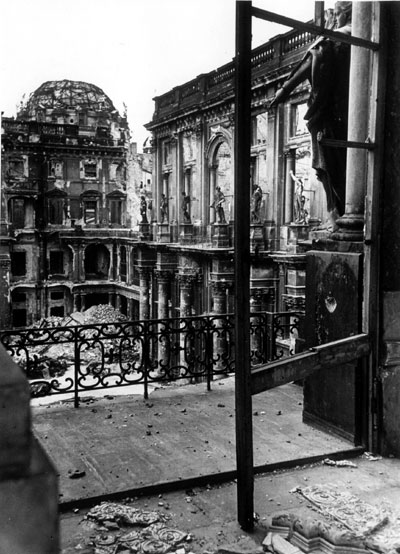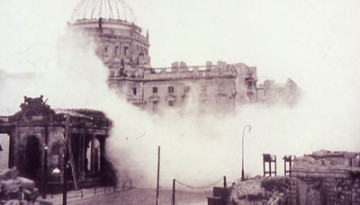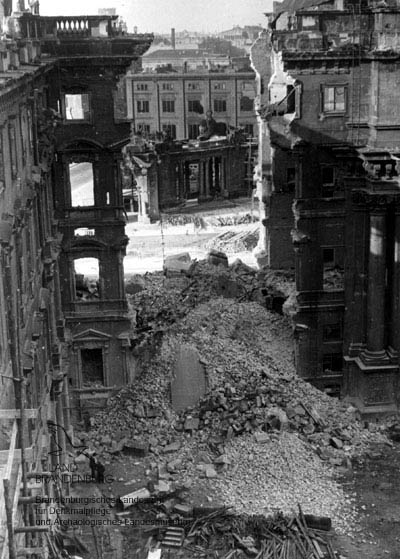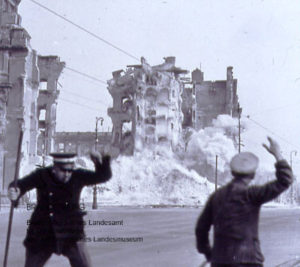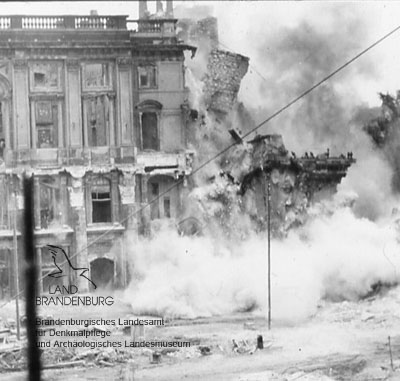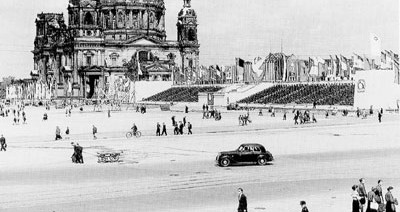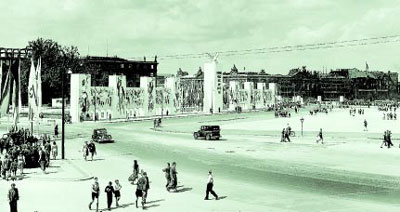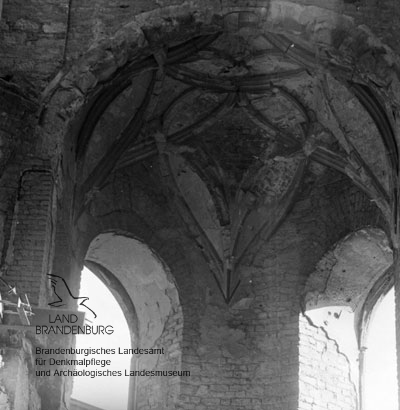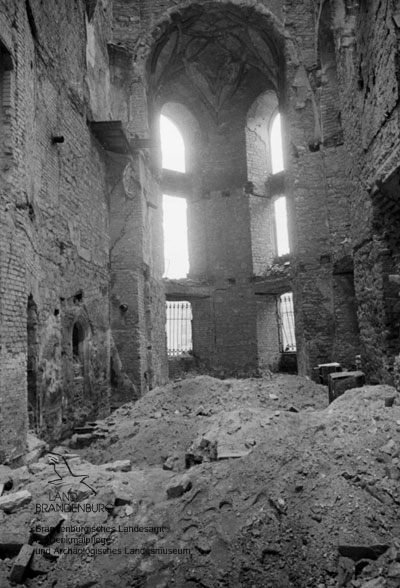On February 3, 1945, during the heaviest bombing attack ever on the city, the Berlin Palace was destroyed by a number of high explosive bombs and numberless incendiary bombs. It burned for almost four days. No efforts to extinguish the fire were undertaken. In view of the daily bombing for almost two years, the Berliners had become resigned to their fate. What was the use of trying to put out the fire, when tomorrow would bring another attack which would negate all their work.
Yet, the huge building was less damaged than, for example, the Charlottenburg Palace. It stood there burned out but still solid and firm. Its demolition was purely an act of arbitrariness.
The leadership of the German Democratic Republic wanted to root out Prussian history for ideological reasons. It was because of this that the Berlin Palace and the Potsdam Palace, as well as the Garrison Church were blown up, although their reconstruction would have been possible as can be seen in the case of the rebuilding of the Charlottenburg Palace, the Würzburg Residence Palace and many other artistic works of architecture after the war.
One can clearly see how well preserved the plasterwork of the burned out room still is after 5 œ years of being exposed to the weather without protection. The Knight’s Hall could have been reconstructed to a great extent in accordance with the original. Yet all this was destroyed in the demolition. (See also “The Interior Rooms”)
When in July 1950 it was decided by the Council of Ministers of the GDR to demolish the Palace, a ground swell of opposition arose. Everywhere there were protests. Here are set forth some of the statements of those in favor of the destruction and those who opposed it. Even today they ring with emotion:
“The center of our capital city, the Pleasure Garden and the area of the present Palace ruins, must become a great square for demonstrations in which the fighting spirit and the will to rebuild of our people can be expressed.”
(Walter Ulbricht, General Secretary of the East German Communist Party, 1950)
“As long as someone does not forcibly shut my mouth, I will not stop protesting against this decision, and indeed, not as a supporter of the West, but rather as a son of the East who is bound in my inmost being to Berlin and its culture and who is at pains in questions of culture to give preference to the East as to those things which it has a right to through its great legacy of art, like the Berlin Palace.”
(Prof. Dr. Richard Hamann, Dean of the Art History Faculty of the East Berlin Humboldt University, 1950)
“In consideration of its European artistic importance, and it historical, urban, and social historical importance, and further in view of the fact that the Palace is a testimony to Berlin architecture over 5 centuries, The German Academy of Science opposes the planned final destruction of the Palace with the gravest misgivings. The Academy does this in fulfillment of its responsibility and its duty to involve itself in the preservation of the culture heritage of the German people in general and the protection of monuments in particular. Among the objects of this sort to be looked after, the Palace stands in the foremost rank.”
(Prof. Dr. Johannes Stroux, President of the Academy of Science, East Berlin, 1950)
“Here stands before us a truly timeless and great structure which even from the ruins still speaks to us in a loud and impressive way. One should save it and rebuild it. In Berlin however, the process of demolition and pulling down buildings continues – the blowing up of the Berlin Palace is an inconceivable act of a fanatical will to destroy which history will judge as senseless and wanton.”
(Prof. Dr. Ernst Gall, General Director of the Prussian and Bavarian Administration for Palaces and Gardens, 1950)

Hundreds of “FDJ” (Free German Youth) members were commandeered as “volunteer building cadres” and sent into the demolished ruins. Surrounded by pictures (from the left) of Grotewohl, Stalin and the State President of the German Democratic republic, Pieck, and supported by a brass band in front of the Neptune Fountain by Portal IV, they worked to build a new Berlin by construction the desolate demonstration square.
“My conscience is at peace. For the moment everyone is crying out, but once the Palace is gone, not one voice will be heard thereafter.”
(Otto Grotewohl, Communist Party, Ministerpresident of the GDR, 1950)
“The resulting formlessly spreading open space would have on it eastern edge (not even at its center) the cathedral as its only accent – that pseudotechtonic construction of misunderstood overblown pomp which has always disturbed the viewer and now, in its isolation, will be even more obtrusive. Do we really want this? Next to the towering cathedral dome, no building in the same avenue – only separated from it by the width of one street – can be erected that can somehow dominate the area. It will always be repressed by the cathedral.”
(Ernst Gall, 1950)
“We had the choice – the palace or the cathedral. If we had torn down the cathedral, then we would have provided the west with grist for the mill for years and they would have accused us of attacking the church. Therefore it was better to choose the Palace. We can deal with the art historians!”
(Wilhelm Girnus, later State Secretary for Technical and Secondary Schooling in the German Democratic Republic, 1951)
“The people in power in east Berlin perceive the fame of the Palace as a discordant note from a long past cult of nobility. This has irritated their sensitive eardrums and must now be hushed. They prefer to hear their own noises on the demonstration square which they have built on the site of the demolished Palace. Yet this bleak square will also one day become a monument, a monument to lack of respect, to narrow mindedness, and to spiritual poverty.”
(Prof. Ragnar Josephson, Svenska Dagbladet, Stockholm, 1950)
 Deutsch
Deutsch English
English Francais
Francais




